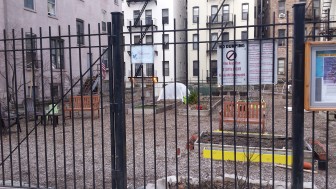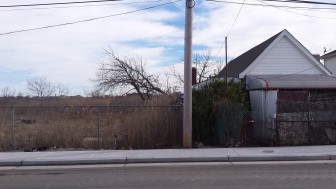
Adi Talwar
Vacant lots in the development pipeline, and not. The active construction site is next to another large space scheduled to be developed soon. Moving up the block, there are other parcels whose fate is not known.
There is the vast green square running astride the elevated 3 train in Brownsville, 100 feet wide and 200 feet long. And there’s the tiny, 14-square-foot triangle wedged between a parking lot and a street in the Melrose section of the Bronx. There’s the large community garden in Harlem—recently spared the shovel thanks to broad political support—as well as the last lot between a dead-end Queens street and the lapping edge of Jamaica Bay.
These are among the 1,131 vacant city owned properties that City Comptroller Scott Stringer said in a February audit “can potentially be developed for affordable housing.”
A City Limits survey of dozens of those sites found that they reflect the varied histories and complicated potential of vacant space in the city.
Some of the parcels scream out for development. In fact, many already are in the process of being built upon. The city’s Department of Housing Preservation and Development (HPD) said in response to the Stringer audit that some 670 of the properties “are suitable and feasible for residential development,” adding: “Roughly 400 of these have been designated or are earmarked for developer designation within the next two years.”
Others on the list appear better suited to remain undeveloped. HPD told Stringer that 310 of the sites “have major development challenges” like sitting “in flood/hurricane danger zones” or suffering from “severe infrastructure deficiencies,” while another 150 “are better suited for non-residential uses.” But HPD won’t say which lots are in the housing pipeline and which are unsuitable for development.
Vanishing vacancies?
Vacant property has played a big role in the city’s past housing initiatives and has figured prominently in new proposals for how to close the gap between housing demand and supply.
When the city first moved to develop privately-owned affordable housing during the 1980s, vacant land was both a rationale and a resource: The city had amassed a huge inventory of property during the abandonment of the 1970s that Mayor Ed Koch wanted to get off the city’s books, and neighborhoods were in need of a stabilizing housing resource that the vacant parcels could help create. Koch’s Ten-Year Plan thrived on that supply of city-owned residential property, and the city continued to move those parcels and buildings into development and private ownership even after the Koch initiative ended.
Source: NYC Comptroller
By the time the Blooomberg administration’s New Housing Marketplace plan took flight, the city had put its last large bundles of vacant land out for bid, leading the Bloomberg team to declare in its 2007 PlaNYC report, “[W]e have virtually no land left.” That reality reflected the success of affordable housing development to that point, but the depletion of the city’s land resources did make affordable housing more expensive to create.
Some officials and advocates had already set out to find more. In 2006, then-Manhattan Borough President Stringer and the advocacy group Picture the Homeless did a street-level canvass to identify both privately and publicly owned vacant lots and buildings. They found more than 2,000 of them. Stringer called for a comprehensive, citywide survey to identify unused territory. A push began to change the way the city’s property tax system treated vacant lots to make it costlier for landlords to keep land idle.
As a mayoral candidate, Bill de Blasio echoed the calls for a property-tax fix to prod vacant territory back into the market, and for a survey to see how much vacant stuff there was. The mayor’s May 2014 Housing New York plan repeated both those pledges. The administration also hinted in its plan that it might seek funding to create a land bank in New York City, and promised the creation of “two new programs to develop small, vacant sites.”
Those programs, the Neighborhood Construction Program (NCP) and the New Infill Homeownership Opportunities Program (NIHOP), are up and running. The survey of vacant spaces is ongoing and the city is looking into a land-trust pilot. The property tax changes are complicated—and involve state action—but are still on the table.
Empty, but not easy
Last autumn, City Limits reported on a protest outside a city auction in the Bronx. Demonstrators were upset that the city was selling off seven parcels rather than using them to build affordable housing. “There are buildings that are zoned residential where nobody lives right now that could become people’s homes,” one of the demonstrators, Paula Segal of the land-use advocacy group 596 Acres, said.
HPD countered that none of the properties were suited for affordable housing. Two of the lots were mere slivers, two were in industrial zones and the rest were too small to permit cost-effective affordable housing, the agency said.
Similar concerns would clearly apply to some of the parcels on the list of city-owned vacant properties that Stringer’s office provided to City Limits after a freedom of information request.
One vacant city owned triangle of land on the corner of Brook Avenue and Third Avenue in the Melrose section of the Bronx dips dramatically down to a gully containing the remnants of the brook for which the avenue is named. A string of sites on the Stringer list sit in a heavily industrial part of Long Island City. Another vacant parcel is mere yards from the storm-vulnerable southeast edge of Staten Island.
Jerilyn Perine, a former HPD commissioner, tells City Limits in an email that a litany of challenges can make what looks like an obvious housing site into a costly if not impractical location. For a piece of land to work for housing, she says, “it has to not have very strange site conditions. The Bronx for example is famous for rock outcroppings and extreme contours that can make building infeasible.”
Perine, now the executive director of the Citizens Housing and Planning Council, continued: “The zoning has to be right, and you can’t just spot-zone for a small parcel out of context. The location has to work for housing (avoiding proximity to highways, noise problems, industrial adjacencies etc). Ownership has to be correct and undisputed: Just because something is on a list as city owned doesn’t mean there isn’t a title dispute that is ongoing or some other litigation. Everything has to be checked carefully.”
“Are there environmental issues – even former building rubble – which can seem benign, but can be problematic? A site can have asbestos, for example. Was an oil tank buried?”

J. Murphy
The Electric Ladybug Garden
Sometimes the obstacle at a site isn’t the site itself but how it has come to be used. Building housing on the site of existing community gardens has been a sensitive issue since the Giuliani era. The de Blasio administration signaled early on that it would take some of those city-owned sites for housing, but since then has spared several garden sites including the Electric Ladybug Garden on West 111th, one of the properties on Stringer’s list.
Another of the sites the comptroller inventoried, on West 52nd Street, is now an empty lot but slated to become the Captain Post community garden, operated by Cultivate HKNY and linked to a 100-percent-affordable housing project next door run by Clinton Housing.
In the works … if slowly
Many of the sites Stringer cataloged, however, are not gardens and don’t display any obvious challenges to development. Several sites along Livonia Avenue in Brownsville are flat, massive and in distinctly residential areas. 1392 Stebbins Avenue in the Bronx looks on a satellite map like a small park. One huge parcel on West 126th is already coated with concrete.
Back in the Bronx, in the Melrose neighborhood a few blocks east of Yankee Stadium, the sites listed as vacant are already spoken for: The huge parking lot between 162nd and 163rd Streets near Elton Avenue is set to become home to WHEDCo’s Bronx Musical Housing Center, retail space and 300 units of affordable housing. Down on Elton and 159th is a corner lot. The developer whose sign is lashed to the chain-link fence of a corner lot two blocks south on Elton Avenue and 159th Street tells City Limits it plans a 2016 closing to produce 30 units of affordable housing at that site and another one nearby. “The apartments will be a mix of one- and two-bedroom and will serve residents living at a range of incomes,” writes POKO Partners LLC’s Andrea Kretchmer. “The exact levels of affordability have not yet been determined.”
But the fate of a string of empty lots at Melrose and 162nd remains unclear. The parcel “is something that we had tried to get site control for in the past and were told by HPD that it was going to be a part of a future RFP,” says Jessica Clemente, the director of Nos Quedamos, the local group whose advocacy in the 1990s introduced what was then an unprecedented degree of community control into the city’s Melrose Commons plan. “I don’t know if that ever happened.”
One of Stringer’s criticisms was that, when the city gets around to deciding what to do with vacant land, it takes a long time to execute. That’s certainly been the case in Edgemere.
More than 100 of the vacant, city-owned sites are located in a corner of the Rockaway Peninsula, between Jamaica Bay and Beach Channel Drive. This is the Edgemere Urban Renewal Area, designated by the City Council in 1997 for a planned 800 units of housing. By 2008, just over 300 units had been completed. The area is a mix of freshly painted houses—some of which have been elevated to meet new flood standards—decrepit structures and vacant lots. In the middle of it all, the city’s Department of Design and Construction is in the midst of a huge capital project installing new sewers and drains.

J. Murphy
Edgemere
Superstorm Sandy complicated the process of completing the renewal work at Edgemere, but the city is nearing the end of an outreach process to develop a new vision for the area and HPD will release a final plan for the area sometime this spring or summer.
For some advocates, the question isn’t just whether housing gets built on a site or not, but what terms govern the affordability and who calls the shots. Rather than turning land over to private owners who provide limited affordability for a set number of years, Segal says, “the land should be used in a way that creates perpetual affordability, with the land under community control.”
The empty spaces on the city’s map—some of which are the vestiges of old urban renewal schemes—reflect failed past efforts by government to dictate the future of individual communities, Segal says, and the city must learn from its history before it builds over it.








